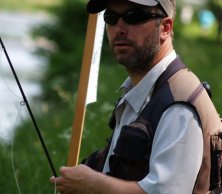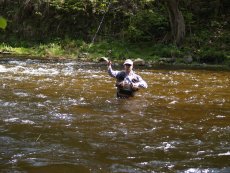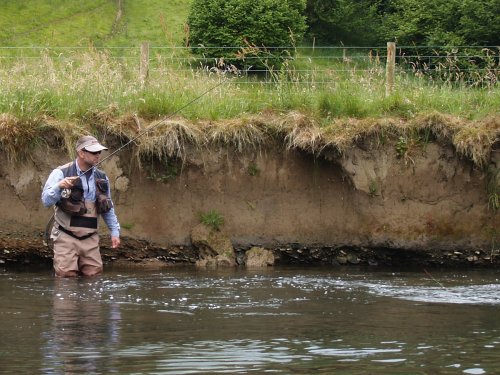Why use the French nymph? – fishing the French nymph technique has many fundamental advantages and differs from classic Czech nymph fishing...
First off - what exactly is French nymph fishing? The equipment and technique is very similar to classical nymph fishing. The difference lies mainly in the substitution of fly line with a fine monofilament leader, which is then fitted with a strike indicator (similar to a quick connector on fly line).
Why use the French nymph? - fishing the French nymph technique has many fundamental advantages and differs from classic Czech nymph fishing:
1) The light and fine leader allows very sensitive fishing in fast currents in both small and especially larger rivers, and particularly at longer distances.
2) A particular stretch can be fished through with significantly higher intensity.
3) The technique allows very precise casts which can be quickly repeated.
4) The finer and more sensitive fishing is less likely to spook fish.
5) It allows precise leading of your flies at a specific depth, which can be easily adjusted.
6) It is high-contact fishing, when you see and feel strikes clearly.
7) Because of the fineness of the technique, you're less likely to lose flies.
What equipment is necessary and appropriate for French nymphing?
The rod is probably the most important piece of equipment. It should be somewhat gentle, with softer action at the tip. For fishing smaller fish (up to about 1 kg) I recommend AFTM 3, and AFTM 4 for bigger fish or snappier fishing. In classical trout waters, about 20 meters wide, a good length is about 2.9 - 3.1 meters. For smaller rivers and streams, 2.7 m is about right, while for larger rivers we might move to something longer than 3.1 m. Rods with extension sections are handy, allowing us to change the length.
The reel - similarly as with other fly fishing techniques, the real is just a backing and line-storage device. It should be chosen so that it is well-balanced with the rod. A wider-diameter reel is recommended. Some anglers like to use an automatic reel that actively keeps the leader wound.
The backing - in light of how the French nymph is fished, with the angler actively using only the leader, any type of backing can be used. It is important, however, that the reel is full, so that the leader is wound in larger diameters and is less likely to coil up from memory effects. An old fly line makes a good backing - using a new and expensive line is just a waste - but just about any kind of backing or thick line will work.
The extension (between the backing and the leader) - I personally use an older leader, or thick tippet (0.30 - 0.40). Many anglers use a thicker saltwater tippet which can be used for both a general backing and in French nymphing.
The leader - I recommend a tapering monofilament leader - my favorite is Hends Camou French leader, made in lengths of 3.5, 4.5, and 9 meters, and in a variety of colors. Because of their high cost (reflected in the quality), I don't recommend experimenting with braided or other types of leader. As mentioned above, a saltwater tippet of any thickness can be used, but they aren't tapered.
The indicator - is a critical part of the setup, and choosing the appropriate color is important. The color should be chosen according to individual taste - meaning whatever you are able to see well (and in varying conditions - shade, sun, twilight, etc). The indicator is also an important weight when casting, especially when using small and lightweight flies. Indicators can be bought already braided or can be made by braiding yourself. Braiding one yourself lets you easily change the length and weight, for instance by changing the knot size, varnishing, or even the size of ending metal rings. Commercial indicators are generally pre-braided, and in appropriate weights for fishing the French nymph technique.
The tippet - one advantage of French nymphing is in the possibility of using an end tippet of any strength, even one that is very fine (for instance 0.08 or 0.06 mm). It doesn't need to be tapered - even a very fine tippet can be tied directly onto the leader. The length of the tippet helps us regulate the depth of the flies.
The flies in French nymphing can the same as for classical nymphing. For easier casting and more precise fishing, I recommend using two or even just one fly. It's always better to have the heavier fly at the tip, where it is less likely to become tangled and is easier to cast. Both beaded flies and flies on jig hooks can be useful as well.
Some interesting info and advice for starting with the French nymph
Precisely leading your flies - thanks to the fixed position of the indicator, it is easy to change the depth of the flies. The depth is adjusted by changing the length of the tippet from the indicator to the flies. You don't have to worry about placing the indicator too close to the flies (such as when fishing shallow water) - fish can't see the indicator.
Using a dry fly - sometimes using a dry fly as an indicator can be very effective (a sedge or palmer is best). At the end of the leader, tie in a branching tippet with a dry fly, then continue the main tippet ended with one or two nymphs. Fishing is similar to using a fly as floater, with the difference that the weight of the droppers doesn't interfere with the action of the dry fly, which is led with the rod. This method is successful in rapid currents, where trout actively patrol for dry flies. You can also re-cast quickly and more intensively cover the site you're fishing.
Fishing for whitefish (coarse fish - chub, dace, roach etc.) - if you like angling for whitefish, you'll appreciate the French nymph technique. Because of the precise and intensive casting, you can effectively cover your chosen stretch. The French nymph is also useful for fishing close to the bank.





















